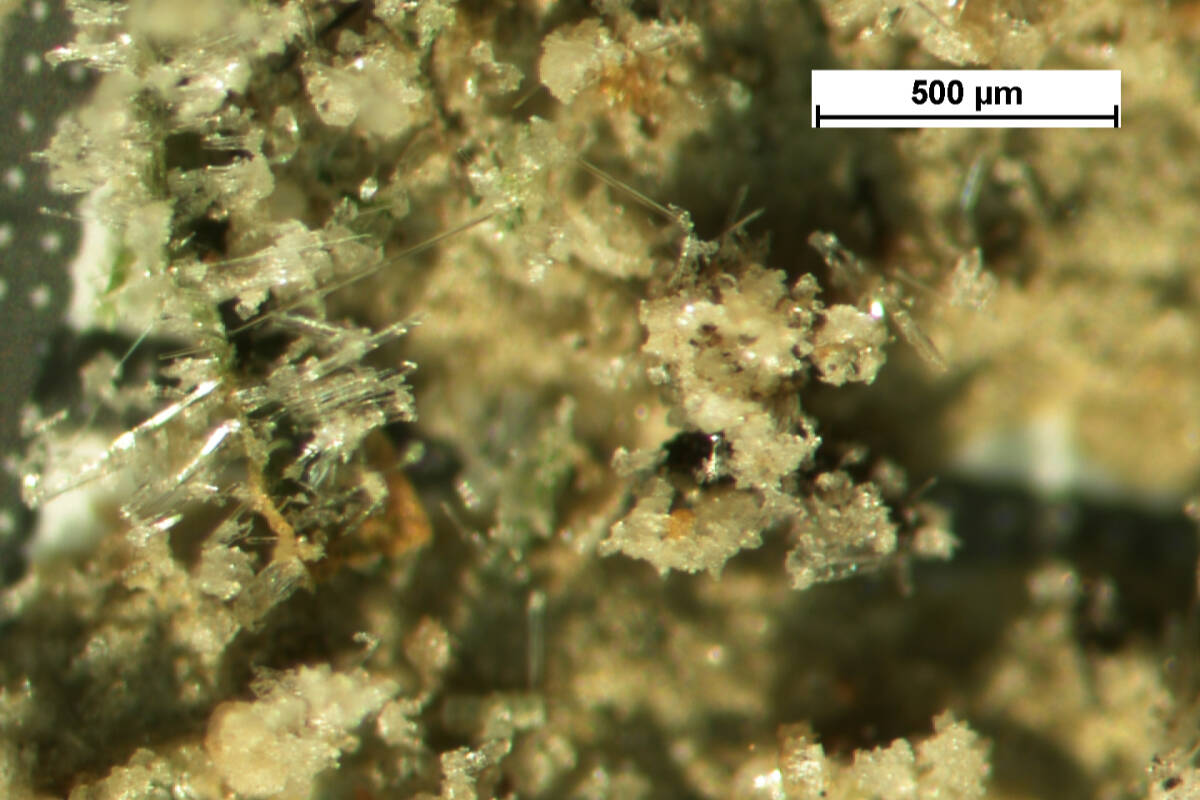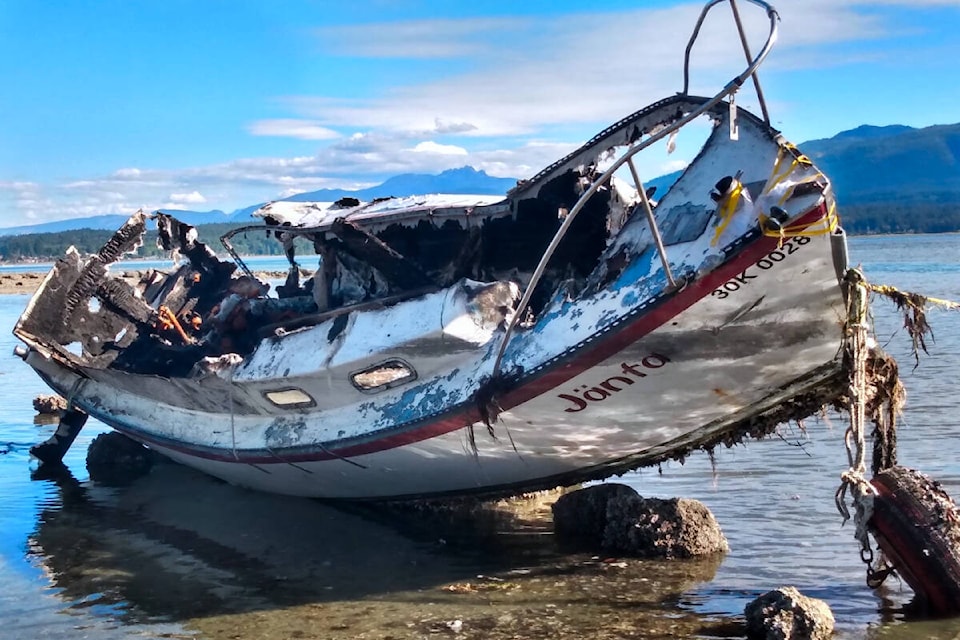This is the second in an investigative series on the issue of derelict and sunken boats on the West Coast: the effects, the damage to the ecosystem, and what is – or what is not – being done to resolve the ongoing problem.
***
Denman Island sits nestled about halfway up the eastern side of Vancouver Island, not far from the bustling Comox Valley.
In the days following a July 16 derelict boat fire on Denman Island’s shoreline, Black Press Media reached out to Nico Prins, the executive director of the B.C. Shellfish Grower Association, to gain insight into the potential impact of this incident on the aquaculture industry in the surrounding Baynes Sound.
While Prins assured that maintaining the quality of the growing environment remains a top priority for shellfish farmers and his association, he stays confident that this specific event would not have any major repercussions on the industry as a whole.
“Realistically, I think this specific instance has a fairly low risk of impacting (our activities),” said Prins. “It might be unfortunate for the individual that owns the nearby lease… but in terms of the risks to the greater industry, I think it’s highly unlikely that this incident will severely impact our operations.”
According to the Black Press Media’s findings, the burnt wreck has a high likelihood to remain beached and untouched for the next few years.
When asked about the potential risks linked to the prolonged exposure of neighbouring tenures to the derelict boat, Prins re-emphasized the low probability of this incident causing any significant harm.
He added that various scientific experiments have been conducted in past years to assess the health of the Baynes Sound - an area known to be a highly sensitive ecosystem.
“Levels of microplastics within the Sound are an order of magnitude lower than what the scientific community would consider a problem,” said Prins. “So that’s positive.”
Prins cited a 2022 scientific paper co-authored by Dr. J.J. Alava, an honorary research associate at UBC; it concluded that the level of microplastics in the Baynes Sound remains well below the established safe concentration threshold.
Although not invalidating Prins’s argument, Alava cautioned about how one interprets his data. The researcher further added that the findings were reached using a specific scientific methodology.
Moreover, the same paper mentioned that: “a detailed analysis of (oceanic) microplastic distributions, and analysis of the uptake of these microplastics by the wider food web, has yet to be performed.”
Additional studies and research are required to improve comprehension of how microplastics affect the broader marine environment.
Microplastics and fibreglass particles
An overlooked source of microplastics that remains significantly understudied is the impact of fibreglass particles shed by ghost vessels.
“We currently live in the ‘Plasticene’ (era) - the age of plastic,” said Alava. “Fibreglass particles are becoming a new emerging pollutant in the ocean. So more research is needed to understand the impact of fibreglass.
“To the best of my knowledge, there’s nothing explicitly focusing on fibreglass particles or the impact of abandoned vessels on the environment to date in B.C. There is not really any scientific literature and that’s something that needs to be addressed.”
One of the first people worldwide to look into this phantom threat is Dr. Corina Ciocan, a marine biologist at the University of Brighton in England.
It all began in 2018 when a conservancy contacted the scholar about the mysterious and steady rise in oyster mortality in the Chichester estuary south of London, which resulted in a fishery closure that same year.
While conducting her research, Ciocan found a staggering concentration of microscopic fragments, three times thinner than a human hair, lodged in the oysters’ flesh.
“In my opinion, as a trained histopathologist, it’s almost impossible for those oysters to ‘spit out’ this fibreglass,” said Ciocan. “Once those shards enter the organism’s tissue, it’s almost impossible for the oyster to get rid of them.”

She eventually found out that those imperishable shards were originating from the hull of fibreglass boats - derelict ones being the most problematic.
Ciocan observed that fibreglass particles impacted marine health, disrupting their eating behaviour, breathing abilities, and reproductive system among other things, as well as potentially causing death.
On the other hand, research has yet to study the risks associated with the consumption of fibreglass-contaminated seafood in humans, Ciocan posits that the latter may result in a range of worrisome ailments.
“For many years, it was very difficult for scientists to identify and prove the impact of microplastics on human health,” she said. “We thought that what we ingested was going to be excreted somehow.
“Now, we realize that some of the particles are small enough that they pass the blood barrier and go into the bloodstream. Some of them are so small that they actually pass the cell barrier and they go into the cells. It’s a completely different picture that we have about the impact of microplastics. They’re going to create quite a pathology down there.”
Though the national inventory estimates that 70 per cent of the 1,491 derelict vessels in Canada are found in B.C. waters, John Roe from the Dead Boat Disposal Society says that this number is outdated and wildly underestimated. In reality, Roe evaluates the number of abandoned boats to be at least 5,000 - 75 per cent of which are made of fibreglass.
However, this issue extends far beyond the realm of shellfish aquaculture.
According to Ciocan’s findings, fibreglass particles bioaccumulate and travel in a wide variety of marine hosts including shellfish, seaweeds, as well as water fleas and sea snails among others. A prey to many, these organisms contaminated with fibreglass can pass their affliction to their predators and potentially create a compounding ripple effect up the marine food web and beyond.
Polystyrene
Though polystyrene (i.e. Styrofoam) may be a material of choice in shipbuilding for its buoyancy, it can also be the bane of many marine organisms.
Once this microplastic makes its way out of a derelict vessel and floats back to the surface it eventually breaks down into smaller pieces. According to Dorrie Woodward, chairperson of the Association for Denman Island Marine Stewards, disintegrated polystyrene is impossible to clean up.
“Polystyrene is everywhere around Vancouver Island,” said Alava. “It is one of the most common microplastics observed in our waters. It is a very pervasive material. Some of my colleagues are saying that it will be basically impossible to remove all of it from our ocean.”
Due to its density being lower than water, polystyrene floats to the surface and can be mistakenly consumed by marine animals, as well as seabirds.
“There’s a disease called ‘plasticosis’ that has been discovered recently because of microplastic consumption by seabirds,” said Alava. “It is a sort of fibrosis induced by plastic particles in the digestive tract of seabirds.”
This man-made disease often causes impairments and occasionally leads to death for those it impacts.
Anti-fouling paint
Anti-fouling paint containing TBT (tributyltin) has been extensively used in the past to coat the hull of vessels. Used for its strong biocidal properties, TBT paint prevents the growth of crustaceans and other sea life in the area of its application.
However, the effectiveness of this toxic paint was such that it was documented to have decimated local populations of non-target organisms.
Banned in 2008, the existence of sunken vessels coated with this lethal substance remains an ongoing source of hazardous pollution.
Boat fire
Although both Alava and Ciocan recognize the singular nature of the incident that unfolded on July 16, they both can’t overlook the hazard created by the blaze, which released a deadly cocktail of toxic fumes in the area surrounding the incident.
The possible presence of PBDEs (flame retardants) and PCBs (coolants and lubricants), two highly carcinogenic compounds also known as ‘forever chemicals’, are worrying Alava.
Yet, these are just a few chemicals out of a long list of pollutants that could have been unleashed by the fire alongside battery acid, oils, gases, lead, and asbestos, to name a few.
Long-term exposure
Time was a subject of chief concern for everyone the Black Press Media contacted for this installment.
According to Roe, it’s not uncommon for ghost vessels to remain submerged at the bottom of the province’s ocean bed and waterways for periods exceeding 20 years.
In the meantime, slowly disintegrating to the rhythm of oceanic currents and bioactivity, these wrecks continue to steadily spew contaminants into the environment.
“The longer these derelict boats remain in the environment, exposed to the elements, the more they have time to release their chemicals and microplastic into the waters,” added Alava. “These boats are basically a persistent source of pollution.”
The purposeful sinking of boats for the creation of artificial reefs may indeed benefit the surrounding marine ecosystem and become a safe haven for marine life. However, Alava warned that the foreign presence of derelict boats more often than not become an ecological death trap for its resident.
The appearance of new hunting grounds for predators or the presence of deadly chemicals might cause the demise of many.
“The reality is that everything that is not natural to the environment is a kind of pollution,” added Alava.
Inaction is not an option
According to Alava and Ciocan, we should act now.
First, Alava proposed the elaboration of a clear and efficient emergency preparedness plan to react promptly when a given incident happens. Time is of the essence when dealing with derelict boats.
Secondly, both scholars strongly advocated for more studies and research to expand our quasi-nil understanding of the impact of these ghost vessels.
Thirdly, Alava proposed that both provincial and federal governments work conjointly in enforcing strong and effective laws to hold boat owners accountable for the abandonment of their vessels.
Lastly, Ciocan and Alava are urging both governments and the boating industry to collaborate on the development of recycling methods for disposing of fibreglass watercraft, as there are currently virtually no viable end-of-life solutions for these vessels.
“I think the action should be immediate,” said Alava. “We don’t have to wait until all these bad things happen to take action. I think we should be preventive instead of reactive.”
After all, Ciocan’s story could serve as a cautionary tale for Canada before the potential occurrence of a major catastrophe.
“We need more evidence so that we can prove, beyond any doubt, that there is time for us to do something,” concluded Ciocan. “The potential for those contaminants to have an impact on (marine ecosystem) is immense.”
***
As of Aug. 13, the burnt derelict vessel still sits on Denman Island’s shoreline.
While writing this article, another derelict vessel sunk in the Comox Harbour.
In 2018, a federal Bill was passed to prevent boat owners from abandoning their vessels. However, four years later, only two fines were levied. What is the root cause for this inaction? The next instalment of the series will look into the governmental mechanism in place to deal with the issue of derelict boats.
READ PART 1: ‘




